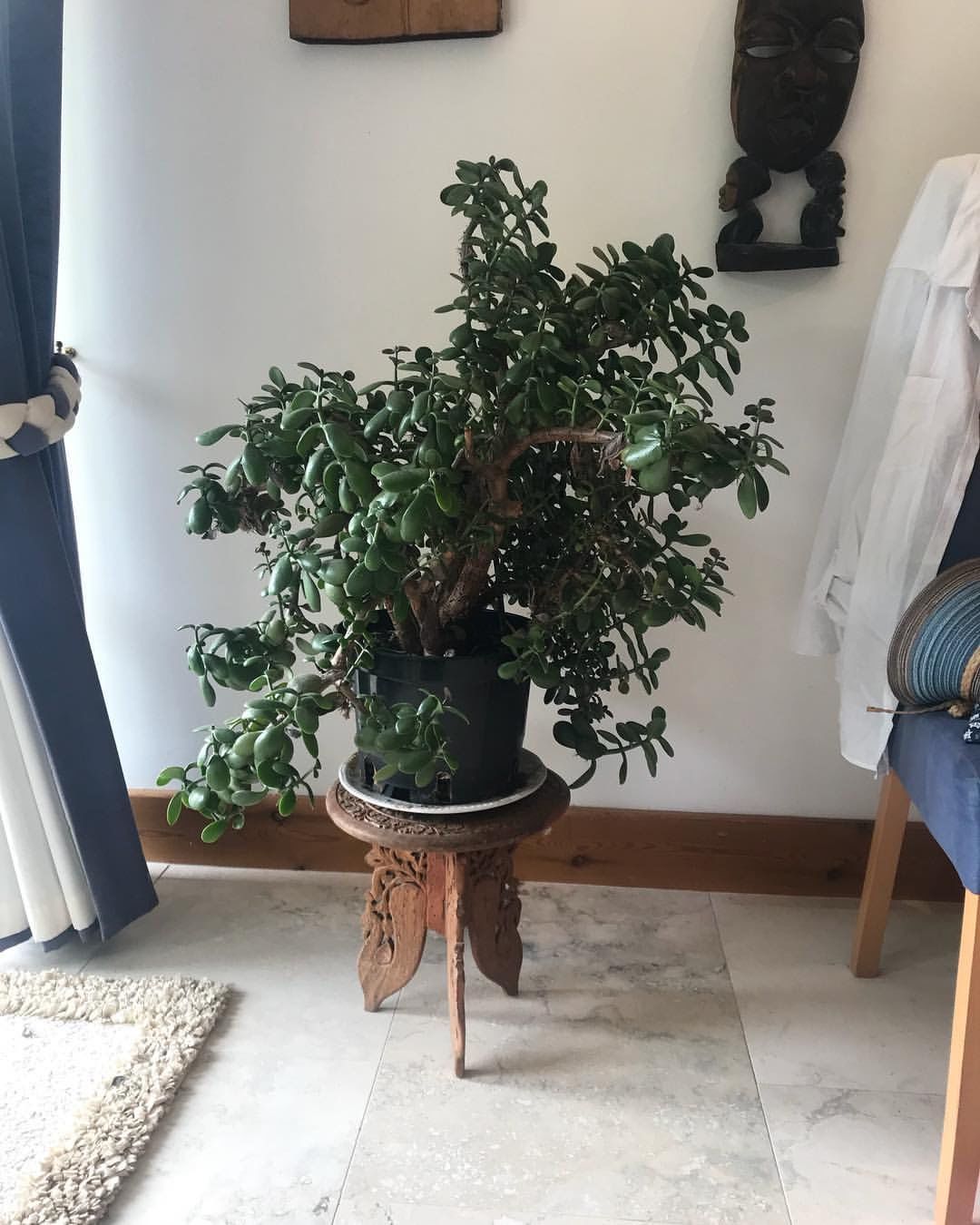
Crassula ovata
Contents
- Top Tips
- Location, Water, Humidity & Fertilisation
- Secrets to Success
- Dormancy Care & Annual Flowers
- Common Issues
- Origins, Temperature, Propagation, Bonsai Shaping/Styling, Repotting & Toxicity
Need the answer to a specific plant query? Book a 1-to-1 video call with THE HOUSEPLANT DOCTOR™, the website's friendly author, to overcome and address your niggling problem! Available on iMessage, WhatsApp, Facebook Messenger & more.
Top Tips & Info
- Care Difficulty - Very Easy
- A few hours of morning or evening sun is mandatory, especially in the winter months. Avoid situating it in a dark location, due to the heightened chance of diseases above, and below the soil line.
- Jade Plants must endure periods of droughts in between irrigations; if you're stuck with when to water, think of the ukhouseplants' phrase of 'Drenches Between Droughts'.
- Fertilise every few months using either a 'Cactus' or 'Houseplant' labelled feed.
- Repot every four years during the spring with a 'Cactus & Succulent' labelled potting mix.
- Information on Bonsai Styling is within the 'Pruning & Maintenance' section!
Location & Light - 🔸🔸🔸
Place the Jade Plant in the brightest location as possible. A few hours of off-peak sunlight will highly benefit the specimen, as it’ll significantly reduce the risk of over-watering and root rot. Due to the intolerance to low light, avoid situating it in areas where a newspaper can’t be read without the use of artificial light.
Water - 🔸
In its natural habitat in Southern Africa, Jade Plants must endure torrential downpours in between prolonged droughts to survive. Keeping this in mind, only rehydrate the soil once it thoroughly dries out - reducing this further during the autumn and winter. For some varieties, pouring cold water directly into the compost could cause yellowed halos around the leaf edges that cannot be undone. Stand tap water overnight in a non-metal container to increase its overall temperature, or use well-stored rainwater for the best results - cold water should be avoided. Under-watering symptoms include shrivelling leaves and stems, little to no growth, gradual decline; these issues are usually caused by too much light or heat, a much needed repot or possible forgetfulness. Over-watering symptoms include yellowing leaves, a collapsed stem, wilting and plant death. Never situate a Jade Plant in a dark location as the combination of both too little light and too much soil moisture will slowly lead to root rot.
Humidity -
Average room humidity is excellent for Jade Plants, as over-misting may cause the development of powdery mildew or botrytis. At monthly intervals, perform a gentle hose-down to hydrate its leaves and reduce the number of dust particles on its foliage, avoiding the risk of excess moisture settling on its foliage.
Fertilisation - 🔸
As naturally-occurring Jade Plants are rarely treated with fertile soil in their habitats of Southern Africa, you'll only need to feed yours every few months. Although we recommend using a 'Cactus' labelled fertiliser, you can still use a 'Houseplant' feed to keep your specimen well-nourished. 'Ready to Use' fertilisers mustn't be directly applied without a pre-water of the soil beforehand.
Secrets to Success
Firstly, a consistent watering schedule is mandatory for quick, reliable growth. We've learnt over the years that as long as you leave the soil to dry out between drenches thoroughly, success is inevitable. Our second piece of advice is to always hydrate over the sink and not in its decorative pot. Leaving the plant in the decorative pot during irrigation will cause a reservoir of standing water that'll kill the roots and eventually the plant itself. Always provide a bright location with a few hours of off-peak direct light either in the morning or evening, but never all day as this will lead to sun scorch. If your Jade Plant is situated in a darker location, be sure to allow the soil dry out longer (for at least two weeks) in between waterings to counteract the chances of root rot.
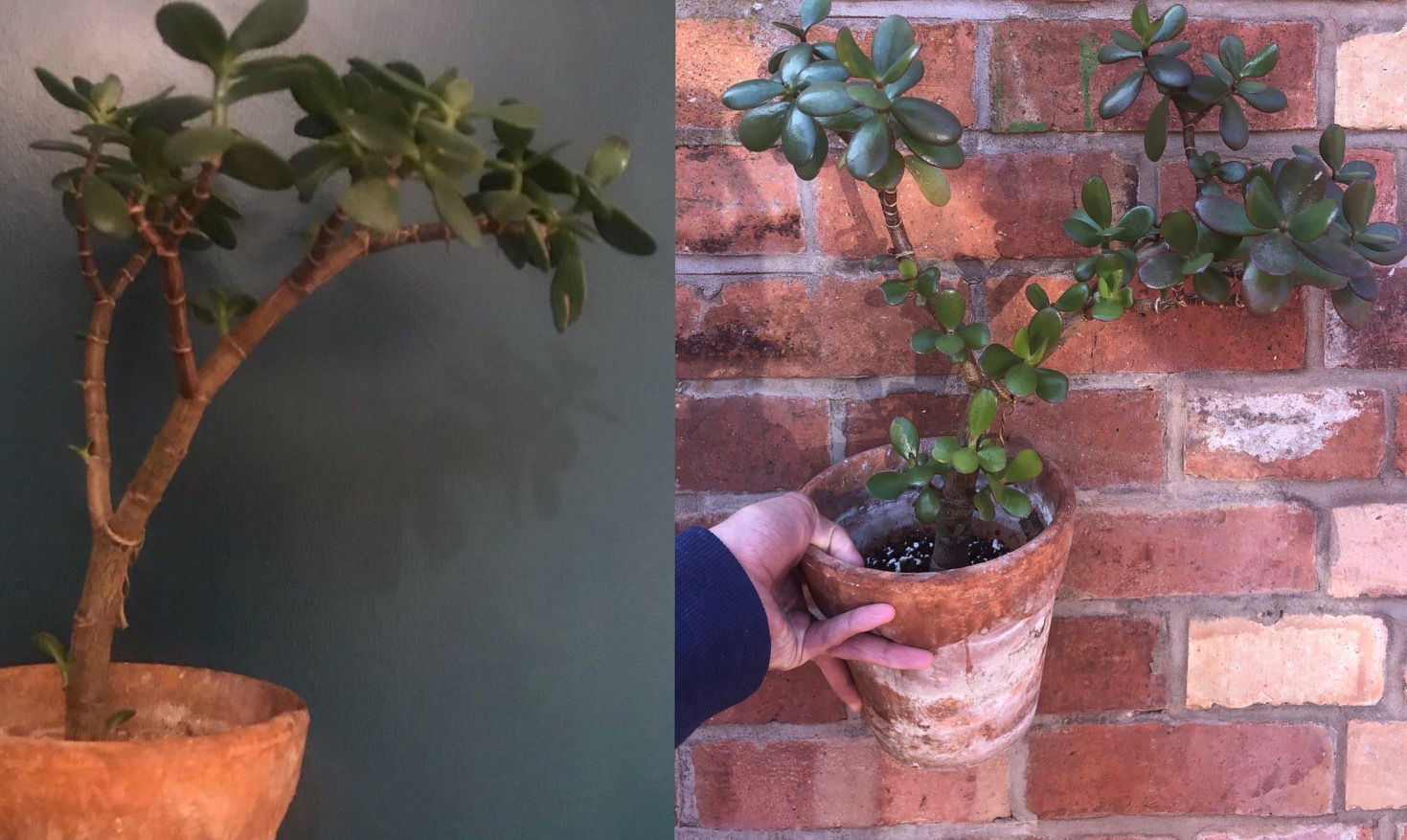 Following our guideline of 'drenches between droughts' will unlock the very best out of your Jade Tree. Pictured above is a period of fourteen months of growth.
Following our guideline of 'drenches between droughts' will unlock the very best out of your Jade Tree. Pictured above is a period of fourteen months of growth.
Common Issues with Jade Plants
Root rot is a common issue with specimens sat in too moist or waterlogged soil for long periods. Symptoms include rapidly yellowing leaves, stunted growth and a rotten brown base. Take the plant out of the pot and inspect health below the soil line. If the roots sport a yellow tinge, you're good to go, but if they're brown and mushy, action must be taken immediately. For already-rotten bases, be sure to read the 'Propagation' section for information regarding leaf or stem cuttings. More information about addressing root rot can be found on this link.
 Thin long growths emerging at the bottom of each stem are just 'adventitious roots' that'll develop just in case the branch breaks off. Once resting on the ground below, the broken stems can quickly root to downplay the risk of dehydration & death.
Thin long growths emerging at the bottom of each stem are just 'adventitious roots' that'll develop just in case the branch breaks off. Once resting on the ground below, the broken stems can quickly root to downplay the risk of dehydration & death.
Yellowing lower leaves (closest to soil) are a clear sign of over-watering, usually caused by too little light. Although Jade Plants can just about do well in darker locations, the frequency of irrigations must be reduced to counteract the chance of root rot. People don't realise that a plant's root system needs access to oxygen too; when soil is watered, the air will travel upwards and out of the potting mix. A lack of accessible oxygen for the roots will cause them to subsequently breakdown over the oncoming days. A location that's too dark will prolong the process of drying soil, along with slowed rates of photosynthesis (& therefore water-intake of the roots). If the specimen is beginning to show signs of over-watering, ease off with the irrigations and reconsider its environment; stem or leaf cuttings should be made to ensure further life. Click on this link to learn more about root rot and how to address it, and always feel the pot's weight for confirmation (heaviness = good soil moisture, & vice versa).

Reddened leaves are the product of too much sunlight, most common during the height of summer. A pigmentation called 'Carotenoids' will alter the appearance of the foliage to protect the leaf from the harsh sunlight. Reduce the amount of time spent in the sunlight by half, while still providing a partially sunny location to avoid environmental shock by placing it in too much shade. There are, however, cultivars and varieties that'll naturally include red or yellow leaf-rims (like the Hummel's Sunset).
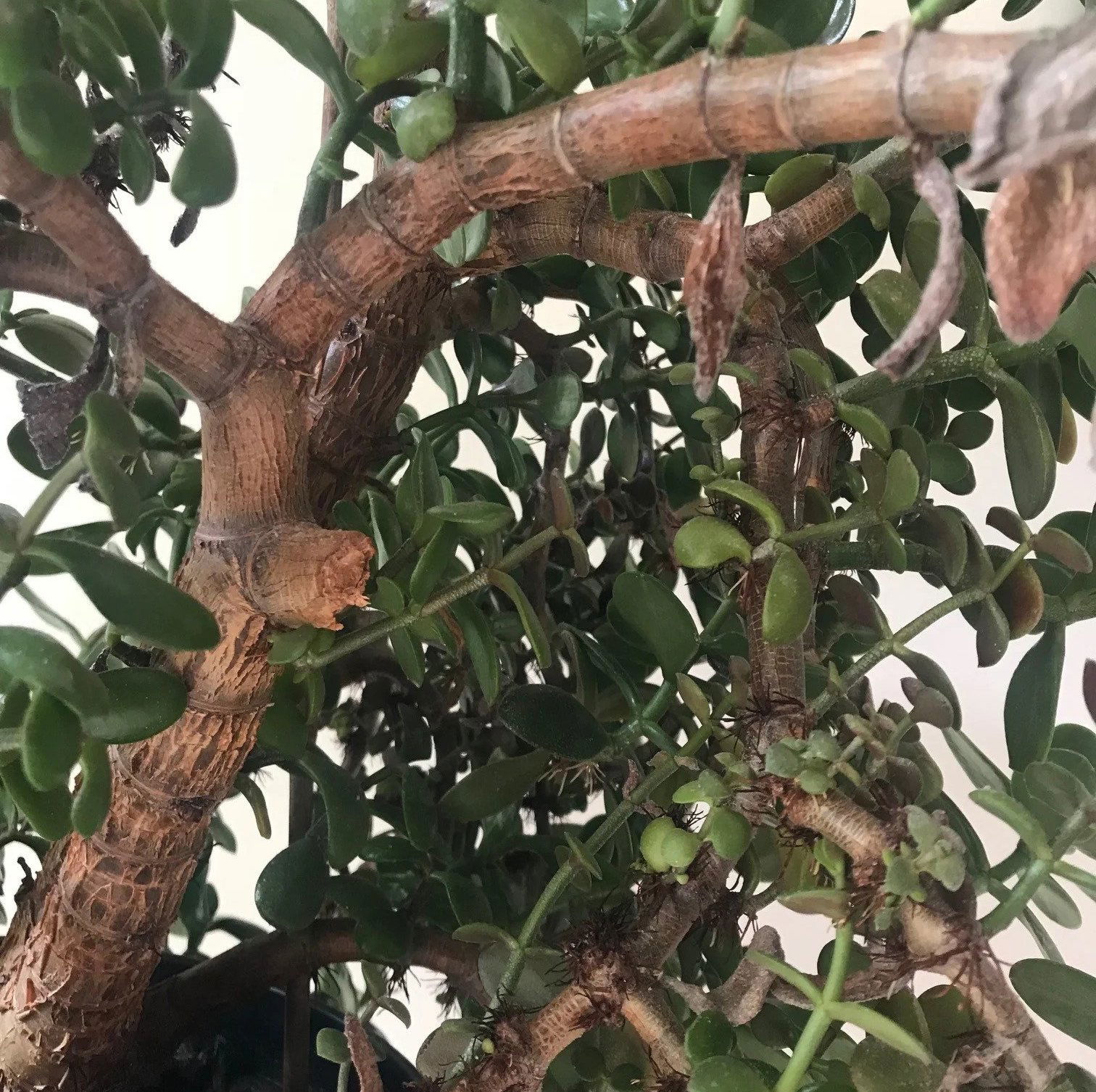 The stems of your Jade Plant (Crassula ovata) will eventually become woody, which is a natural part of its life.
The stems of your Jade Plant (Crassula ovata) will eventually become woody, which is a natural part of its life.
Curled or reddened leaves with dried brown edges are the result of too little water and over-exposure to the sun. Although they can naturally do well in sun-filled locations, those that haven't acclimatised to the harsh rays will show signs of sun-scorch and environmental shock. Prolonged exposure will significantly speed the process of dehydration, so consider transplantation into a bigger pot in the Spring to wrap the roots around moister soil.
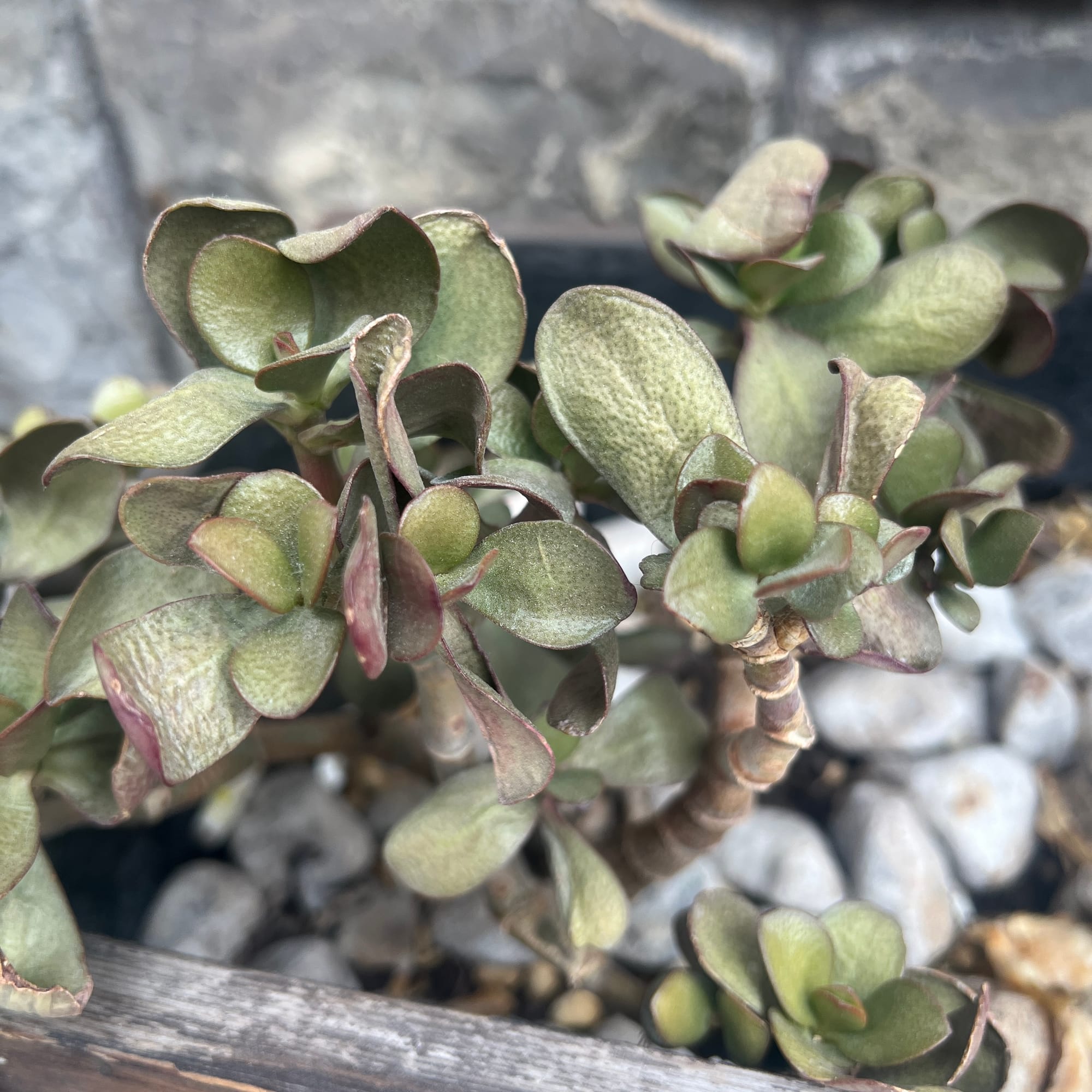
Another sign of severe dehydration is the foliage beginning to wrinkle over until the Jade Tree's leaves are wafer-thin. Increase the watering frequency to every fortnight and see if this subsides the symptoms. You should see signs of improvements within a few weeks but if not, you might have to take stem cuttings to keep the plant's 'legacy' alive.
Pests could arise at any time, with infestations starting from the original nursery or via contamination in your home. Mealybugs tend to be the usual inhabitants, with white cottony webs developing across the foliage and stems. Thoroughly check the plant's cubbyholes before giving it the all-clear, or click on the link above to learn more about eradicating these issues.
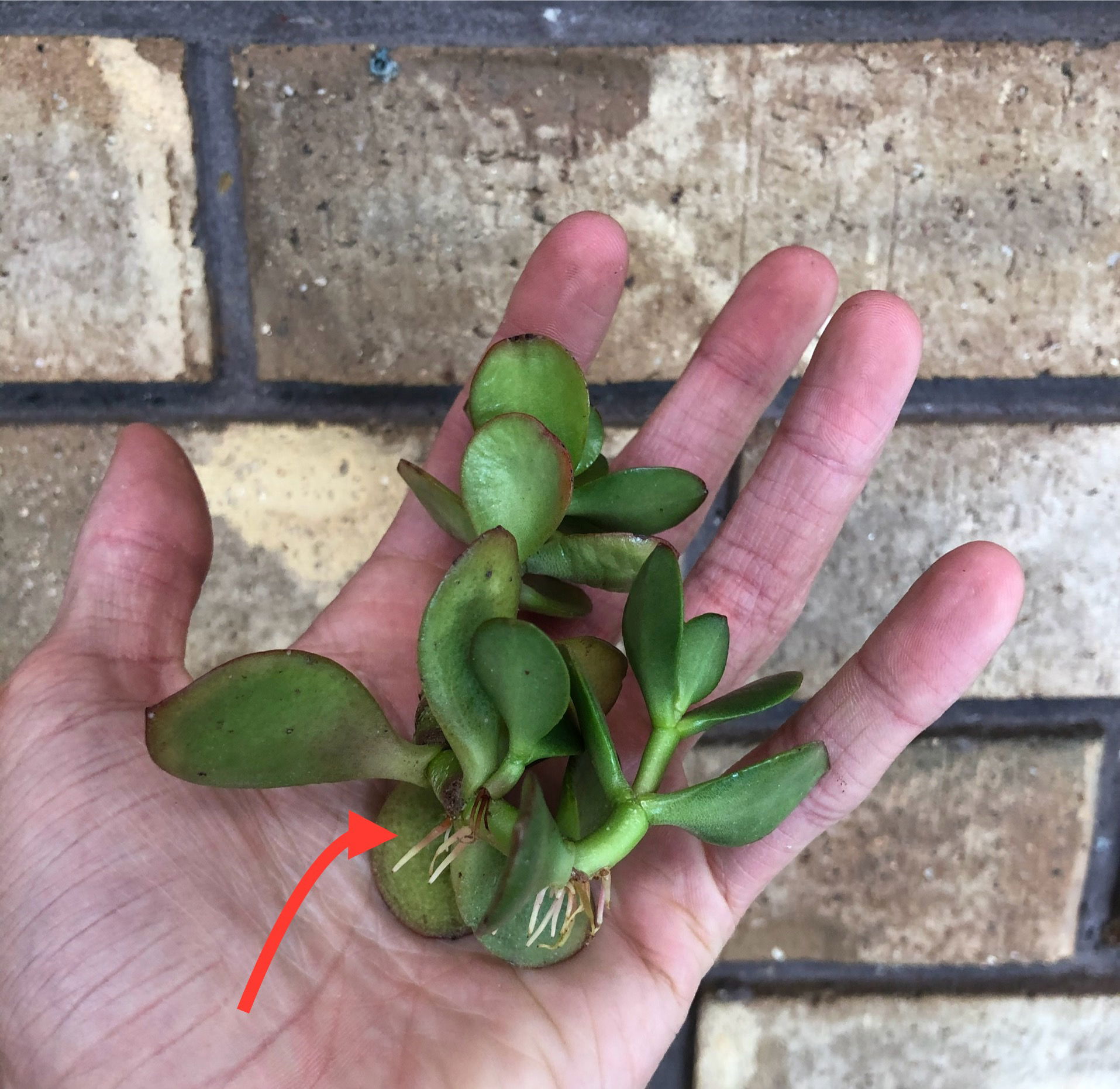 Accidentally knocked off a branch? Turn this into a stem cutting by rooting it in a 7cm pot with 'Cactus & Succulent' labelled potting mix & you'll have a new plant in your collection.
Accidentally knocked off a branch? Turn this into a stem cutting by rooting it in a 7cm pot with 'Cactus & Succulent' labelled potting mix & you'll have a new plant in your collection.
Failed propagated leaf or stem cuttings - There are several reasons why the cuttings haven't rooted well, including; the time of year (spring or summer is best), its size (stem cuttings to be at least 4cm in length, whereas leaf cuttings should be mature & not damaged), poor growing conditions (replace water weekly for water-propagated cuttings, and avoid over-watering for soil-grown plants), and its growing environment (a bright sunless windowsill and warmth is important whilst it matures).
Rinse the leaves regularly. Although this isn't too much of an issue, a build-up of dust particles can clog up the plant's pores, causing lowered light capturing-efficiency. Gently hose the topside of the leaves in the shower (or outside) each month to improve growing rates.
Origins
Crassula is a genus consisting of two hundred species with natural distributions around the world, mostly originating from Africa. It’s name, Crassula, derives from the Latin word for ‘thick’, referring to the plump leaves that store water for potential droughts. The C. ovata was first formally described in 1768 with ovata referring to the ‘egg’ shaped leaves.
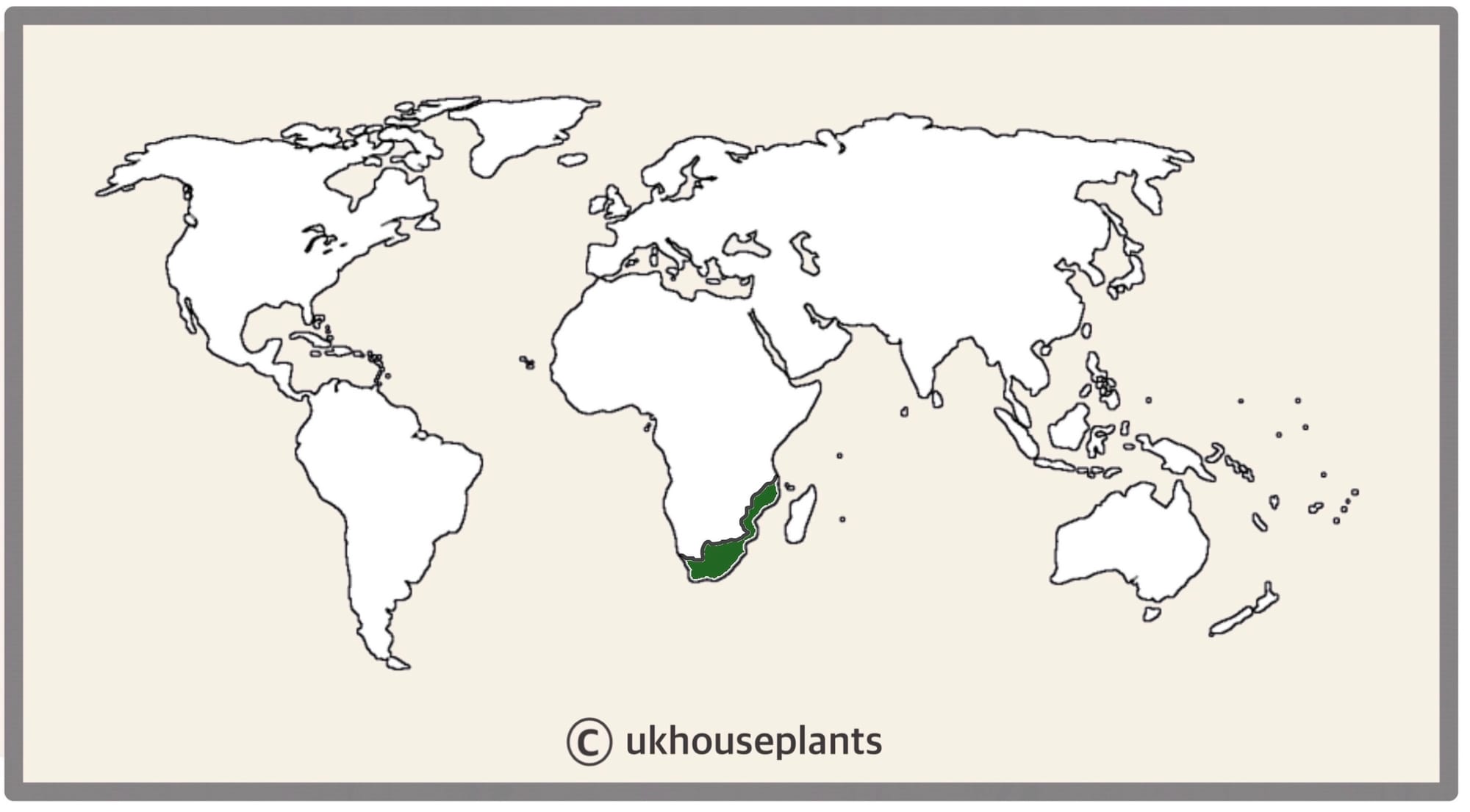 The Distribution of Crassula ovata.
The Distribution of Crassula ovata.
Temperature
12° - 26°C (54° - 78°F)
H1b (Hardiness Zone 12) - Can be grown outdoors during the summer in a sheltered location with temperatures above 12℃ (54℉), but is fine to remain indoors, too. If you decide to bring this plant outdoors, don't allow it to endure any direct sunlight as it may result in sun-scorch and dehydration. Regularly keep an eye out for pests, especially when re-introducing it back indoors.
Spread
Up to 2m in height and 1.5m in width indoors when repotted every three years. The ultimate height will take between 15-30 years to achieve, but can live for over 40 years or more when correctly cared.
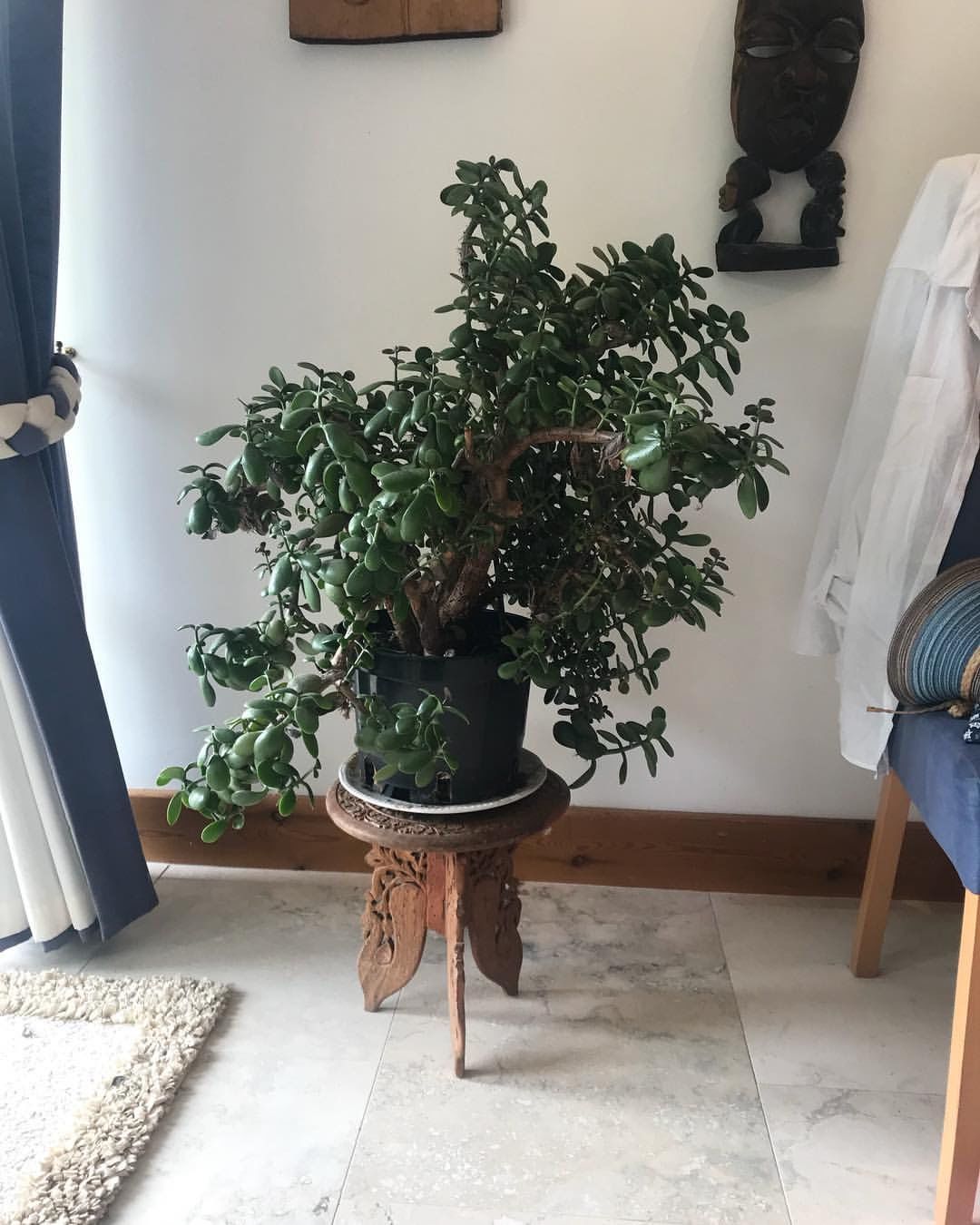 A twenty year old Crassula ovata.
A twenty year old Crassula ovata.
Pruning & Maintenance
Stem cuttings can be taken to reduce the height of the specimen. Remove yellow or dying/crisping leaves, and plant debris to encourage better-growing conditions. Remember to make clean incisions/cuts as too-damaged wounds may shock the plant, causing weakened growth and a decline in health.
Bonsai Styling
Styling a Jade Tree into Bonsai is easy due to the flexibility of its stems. If you're interested in shaping your Tree, we recommend using malleable Bonsai wire and wrap around the stem like the image below. Annual pruning in the early spring is also important to create a tree-like appearance!
 Once wrapped, be sure to gently bend the stem into your desired shape. Loosen the wire slightly (while keeping the general shape) after 12 months to avoid the stem scarring & remove once it's not needed anymore.
Once wrapped, be sure to gently bend the stem into your desired shape. Loosen the wire slightly (while keeping the general shape) after 12 months to avoid the stem scarring & remove once it's not needed anymore.
Propagation
Via Seed, Leaf or Stem Cuttings.
Leaf Cuttings (Easy) - Leaves that are halfway along the stem have the most potential due to its size and maturity. Gently place your fingers between the mother's stem and the leaf's base, pulling it downwards until you hear a snap. Ensure the wound is wholly intact with no damage as a bruise or tear will result in unsuccessful propagation. Set the leaf ON TOP OF a bed of moist Cactus & Succulent Compost for root growth. Not only will this callous the wound (to prevent disease), but it'll also speed up the propagation process considerably. Once there's at least 0.3cm of root development (pictured above), place it one third into the compost, at a slight angle. Provide a bright setting with temperatures around 18°C (64°F) with the majority of the soil drying out in between waters. New leaves should emerge within the next month, as long as the soil is kept on the drier to life.
Stem Cuttings (Easy) - Using a clean pair of scissors, cut a 5-10cm (2-4 inch) section from the stem's tip with at least four leaves. Be sure to use a fresh, damage or pest-free piece as unhealthy branches are more likely to fail. Remove the older half of the leaves, so the stem's half is bare to speed the process of root development. Purchase a 'Cactus & Succulent' compost and vertically push the cutting's base into the soil, avoiding the risk of covering the foliage with soil. Situate the cutting in a sunless windowsill with temperatures above 18°C (64°F) and mist the plant and top layer of the soil every two days with warm water. The root system will develop first before its leaves, so as soon as new leaves emerge you can treat it as a mature specimen.
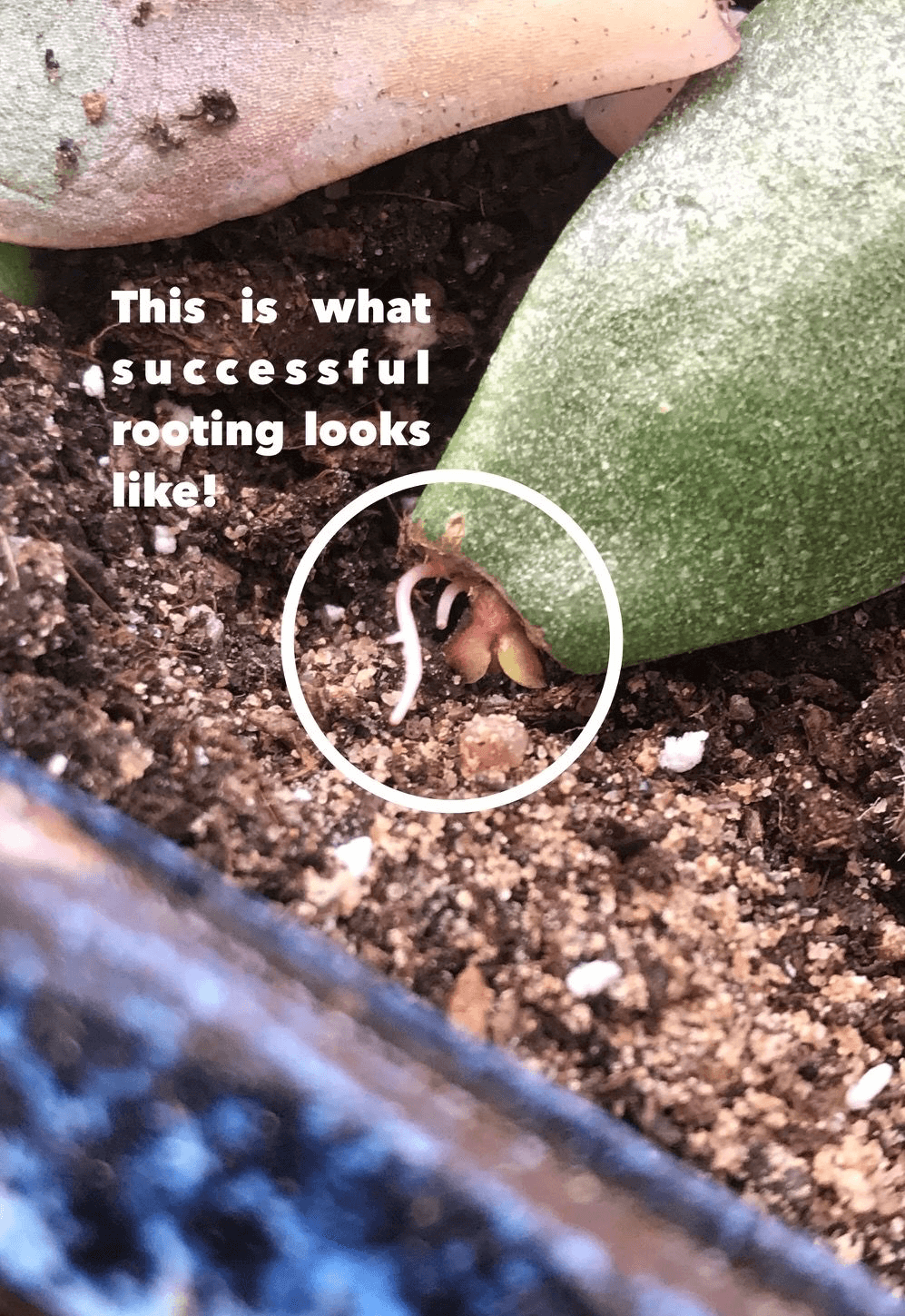
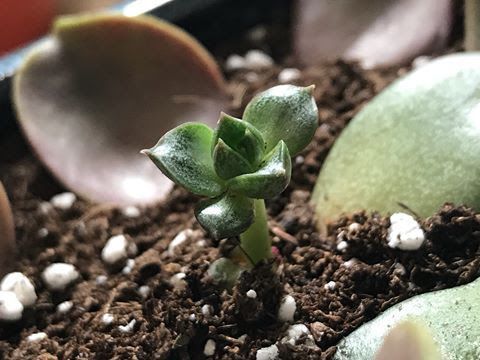 The leaf should have its bottom third submerged in soil to access the soil moisture.
The leaf should have its bottom third submerged in soil to access the soil moisture.
Flowers
After around five years of growth, your Jade Plant may produce small clusters of pink or white scented flowers during the winter period, lasting up to six weeks!
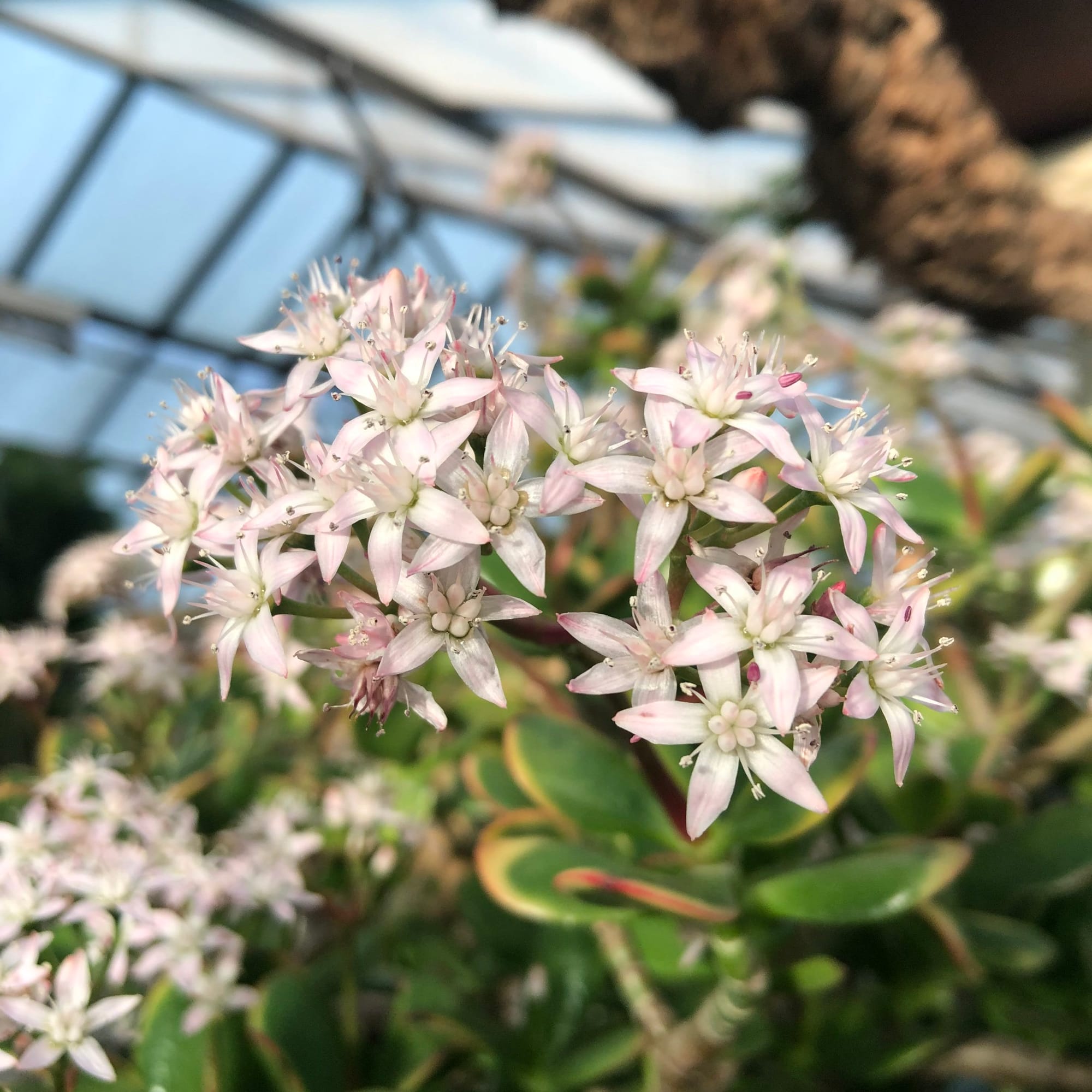 Larger specimens can support multiple clusters of flowers on each stem tip, producing an absolute showstopper of a spectacle in the height of winter.
Larger specimens can support multiple clusters of flowers on each stem tip, producing an absolute showstopper of a spectacle in the height of winter.
Repotting
Repot every four years in spring using a 'Cactus & Succulent' labelled compost and the next sized pot with adequate drainage. Jade Plants are far better being potbound for several years due to the heightened risk of root rot and repotting-issues (like transplant shock), so only repot if you feel it's necessary.
Hydrate the plant 24hrs before tinkering with the roots to prevent the risk of transplant shock. We'd recommend adding a thin layer of small grit in the pot's base to improve drainage and downplay over-watering. Click here for a detailed step-by-step guide on transplantation, or via this link to learn about repotting with root rot.
Pests & Diseases
Keep an eye out for mealybugs, aphids, scale, blackfly, vine weevils & root mealybugs that'll locate themselves in the cubbyholes and undersides of the leaves, except for the latter two in the soil. Common diseases associated with Jade Plants are root rot, leaf-spot disease, botrytis, rust, powdery mildew & southern blight - click here to learn more about these issues.
Toxicity
This plant is classified as poisonous. If parts of the plants are eaten, vomiting, nausea and a loss of appetite could occur. Consumption of large quantities must be dealt with quickly; acquire medical assistance for further information.
Retail Locations
Dobbies, Blue Diamond, British Garden Centres, IKEA, Facebook Market, Online Stores.
Book a 1-to-1 Call with THE HOUSEPLANT DOCTOR™
If you need further advice with your houseplants, book an advice call with ukhouseplants' friendly and expert writer today! This can be done via a video or audio call on most apps, including Facebook, FaceTime & Skype. A ten-minute call costs £5.99 (US$7), or £15.99 for thirty minutes. You can ask multiple questions, including queries on plants, pests, terrariums, repotting advice and anything in between. Please consider supporting this service to keep ukhouseplants thriving!